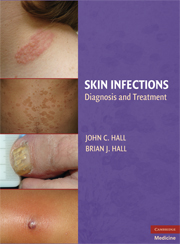Book contents
- Frontmatter
- Contents
- List of Contributors
- Acknowledgments
- INTRODUCTION
- TECHNIQUES IN DIAGNOSING DERMATOLOGIC MANIFESTATIONS OF INFECTIOUS DISEASES
- PRINCIPLES OF MANAGEMENT OF DERMATOLOGIC INFECTIONS IN THE SKIN
- PART 1 COMMON INFECTIONS
- PART II LESS COMMON INFECTIONS
- PART III INFECTIONS IN SELECTED ECOSYSTEMS
- PART IV INFECTIONS IN SELECTED PATIENT POPULATIONS
- PART V INFECTIONS OF SPECIFIC SKIN-ASSOCIATED BODY SITES
- PART VI SPECIAL DISEASE CATEGORIES
- 23 INFECTIONS IN SKIN SURGERY
- 24 VENEREAL DISEASES
- 25 LIFE-THREATENING SKIN INFECTIONS: SKIN SIGNS OF IMPORTANT BACTERIAL INFECTIOUS DISEASES
- Index
25 - LIFE-THREATENING SKIN INFECTIONS: SKIN SIGNS OF IMPORTANT BACTERIAL INFECTIOUS DISEASES
from PART VI - SPECIAL DISEASE CATEGORIES
Published online by Cambridge University Press: 08 January 2010
- Frontmatter
- Contents
- List of Contributors
- Acknowledgments
- INTRODUCTION
- TECHNIQUES IN DIAGNOSING DERMATOLOGIC MANIFESTATIONS OF INFECTIOUS DISEASES
- PRINCIPLES OF MANAGEMENT OF DERMATOLOGIC INFECTIONS IN THE SKIN
- PART 1 COMMON INFECTIONS
- PART II LESS COMMON INFECTIONS
- PART III INFECTIONS IN SELECTED ECOSYSTEMS
- PART IV INFECTIONS IN SELECTED PATIENT POPULATIONS
- PART V INFECTIONS OF SPECIFIC SKIN-ASSOCIATED BODY SITES
- PART VI SPECIAL DISEASE CATEGORIES
- 23 INFECTIONS IN SKIN SURGERY
- 24 VENEREAL DISEASES
- 25 LIFE-THREATENING SKIN INFECTIONS: SKIN SIGNS OF IMPORTANT BACTERIAL INFECTIOUS DISEASES
- Index
Summary
An important group of bacterial infectious diseases are life-threatening conditions that require immediate intervention and treatment. Appropriate diagnosis and management of this group of severe bacterial infections can be expedited by recognition of their distinctive cutaneous findings. The clinical manifestations, diagnosis, and management of meningococcal disease, Rocky Mountain spotted fever (RMSF), Staphylococcal toxic shock syndrome, and Streptococcal toxic shock syndrome will be highlighted herein with emphasis being placed on their cutaneous signs.
HISTORY
Reports of illnesses resembling meningococcal disease date back to the 1500s. The description reported by Vieusseux in 1805 is considered the first identification of the disease, and the causative organism was first isolated by Weichselbaum in 1887. Today, meningococcal disease remains a feared cause of significant morbidity and mortality throughout the world.
Rocky Mountain spotted fever (RMSF) was first described in Boise, Idaho, by Marshall Wood, an Army Physician in 1896. More than 100 years have elapsed since Howard T. Ricketts first identified the pathogen and demonstrated its transmission by Montana ticks. Four years after his classic investigation, Ricketts died at the age of 40 of epidemic typhus while investigating that disease in Mexico City.
Toxic Shock Syndrome (TSS) was first described in 1978 by Todd and associates as a complication of infection by Staphylococcus aureus. An early association was made between TSS and concomitant tampon usage in menstruating women. The sudden increase in TSS in the early 1980s was temporally related to the introduction of these super absorbent tampons, which were subsequently withdrawn from the market.
- Type
- Chapter
- Information
- Skin InfectionsDiagnosis and Treatment, pp. 322 - 328Publisher: Cambridge University PressPrint publication year: 2009

